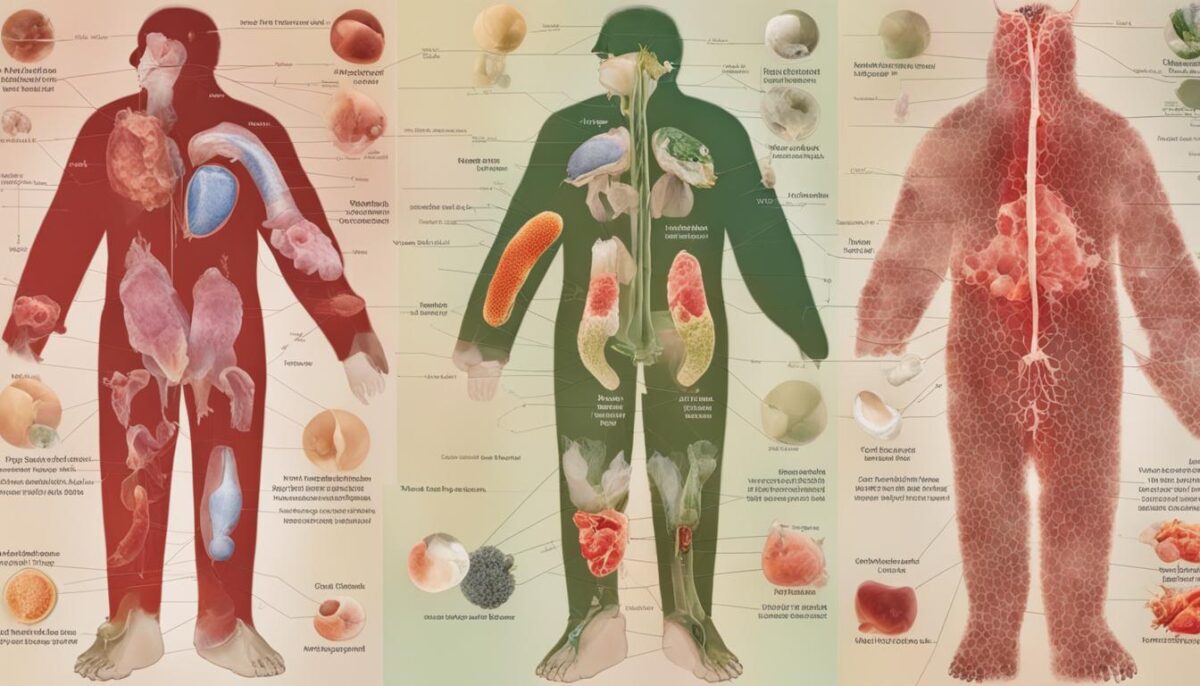Hey there! Have you ever heard of Hand Foot Mouth Disease? It’s a sickness that many kids get, with itchy spots on their hands and feet, and sometimes sores in their mouth. It’s not fun, and it spreads easily among people, especially kids. But what about your furry friend? Can dogs get Hand Foot Mouth Disease, too? This is something many pet owners wonder about. You love your pet and want to make sure they’re healthy and safe, right? Well, we’re here to talk about this disease and whether it’s a concern for our canine pals.
As a pet owner, it’s important to know about the illnesses that could affect your dog. While you might be familiar with a lot of doggy diseases, Hand Foot Mouth Disease, also known as HFMD, is a bit different. It usually affects humans, but do you need to worry about your dog catching it? Let’s find out and make sure you’re up to speed on pet health and infectious diseases in pets.
Key Takeaways
- Hand Foot Mouth Disease is common in humans, not dogs.
- HFMD is different from the illness in cattle and pigs.
- Dogs have their own health issues to watch out for.
- Good hygiene helps keep your pets and family safe from diseases.
- It’s always good to learn about pet diseases and how to prevent them.
Understanding Hand, Foot and Mouth Disease in Humans
Have you ever wondered how a common illness like Hand, Foot and Mouth Disease, often called HFMD, affects people? This sickness is caused by certain viruses and it spreads quite easily. Let’s figure out what’s behind it and how we can recognize its symptoms.
What Causes HFMD in People?
HFMD causes can be pretty simple to understand. Think of it as a tiny, unwelcome guest at a party – specifically, viruses such as Coxsackievirus A16 or Enterovirus 71. These are the main germs that crash our body’s systems and bring about HFMD.
How HFMD Spreads Amongst Humans
HFMD transmission is a bit like sharing toys; it’s that easy to pass it on. When someone with HFMD coughs, sneezes, or even touches something like a doorknob, they can leave the virus behind for someone else to pick up. People can also get HFMD by getting close to someone who is sick or touching their blisters or their stool.
Remember, the germs that cause HFMD can hang around even after the sick person feels better, which means they can keep sharing the illness without knowing it.
Common Symptoms of HFMD in Humans
When someone gets HFMD, they can show signs like a fever, feeling super tired, or sore throat. HFMD symptoms also include painful sores in the mouth and a rash on the hands and feet. Sometimes the rash can show up on the knees, elbows, or even the bum!
It’s important for everyone, especially kids and parents, to know how to spot these signs. That way, they can take care to not spread HFMD to their friends and family. Here’s a simple table to help you remember the most common symptoms:
| Symptom | What It Looks Like | What You Might Feel |
|---|---|---|
| Fever | High body temperature | Maybe chills or sweating |
| Mouth Sores | Small, painful spots in the mouth | Pain when eating or drinking |
| Rash on Skin | Red spots, sometimes with blisters, on hands and feet | It might itch, but usually, it doesn’t hurt |
So now you understand a bit more about HFMD causes, how it moves from person to person, and what symptoms to watch for. Being informed means you can help stop the spread of HFMD!
Hand Foot and Mouth Disease vs. Foot and Mouth Disease in Animals
It’s easy to get confused between Hand Foot and Mouth Disease (HFMD) and Foot and Mouth Disease (FMD) since their names are so much alike. However, these two are caused by different types of animal viruses. To clear up any confusion, let’s dive into what sets them apart.
The Differences between HFMD and FMD
HFMD, a common illness in young kids, is all about sores and rashes on the hands, feet, and around the mouth. It’s caused by viruses that usually don’t bother animals at all. On the other hand, FMD is a big deal for animals like cows and pigs, but not for humans. It’s super contagious among livestock and can spread really fast.
Viruses Affecting Animals and Humans: A Distinction
There’s a variety of viruses that can make animals and humans sick, but they usually have their own favorites to infect. With HFMD and FMD, the viruses that cause them are picky about who they affect. For instance, the viruses behind HFMD—like Coxsackievirus—typically stick to humans.
| Disease | Affected Species | Type of Virus | Common Symptoms |
|---|---|---|---|
| HFMD | Humans, primarily children | Enteroviruses such as Coxsackievirus | Sores in mouth, rash on hands and feet |
| FMD | Livestock (Cattle, Sheep, Goats, Pigs) | Foot and Mouth Disease Virus | Blisters on mouth and feet, fever, decreased appetite |
When it comes to taking care of your pets or farm animals, it’s really important to know about these viral diseases. Remember HFMD vs FMD—two very different issues, each with their own set of troubles.
Can Dogs Get Hand Foot Mouth Disease?
Hey there, pet lovers! Have you ever wondered if your furry friend can catch Hand Foot Mouth Disease (HFMD)? It’s a common worry, especially when HFMD pops up in people. So, let’s clear things up: HFMD in dogs isn’t something you need to worry about. This yucky illness mostly sticks to humans, meaning your pooch is safe from this particular bug.
When it comes to pet diseases, there are tons of them out there, but HFMD isn’t typically on the list for your canine companions. Canine illnesses can be pretty rough, but thankfully, HFMD is not known to be one of them. It’s important to remember that while humans and their four-legged friends share lots of love, they don’t always share the same illnesses.
HFMD likes to stick to people, and the viruses that cause it aren’t looking to hang out with dogs. So when you hear about HFMD going around, you don’t have to hide your pup away. Instead, focus on keeping yourself clean and healthy, and you’ll be doing plenty to help keep canine illnesses at bay, too.
As always, if you’re ever worried about your pet’s health, it’s best to talk to your vet. They are the pros when it comes to all things HFMD canine susceptibility and beyond. Stay safe, cuddle your dog, and leave HFMD worries at the door!
Transmission of Viruses from Animals to Humans and Vice Versa
Have you ever wondered if people can catch certain sicknesses from animals or give them to pets? Well, it’s pretty important to know about animal to human virus transmission, and how it can work the other way around too. Keeping everyone safe should be a top priority, especially when dealing with farm animals or wildlife.
Risks Posed by Close Contact with Infected Animals
When you’re near animals that might be sick, like those with Foot and Mouth Disease (FMD), there are risks you should be aware of. This doesn’t happen a lot, but people like farmers, vets, or kids who hang out with animals could get sick from them. Air can carry this virus, meaning if an infected animal coughs or sneezes, the germs can travel to you. That’s why washing your hands and being clean around animals is super important.
Precedents of Cross-Species Virus Transmission
There have been times when viruses move between different kinds of animals, like from sheep to dogs. In some parts of the world, dogs have shown signs that the FMD virus affected their hearts after eating meat from infected animals. This goes to show that animals can get sick from each other, not just from people or nature. These kinds of animal health risks make us remember to be really careful in how we handle animals and what we feed our pets.
FAQ
What Causes HFMD in People?
Hand, Foot, and Mouth Disease in humans is caused by various viruses from the enterovirus family such as Coxsackievirus A16, Enterovirus 71 (EV-A71), and sometimes Coxsackievirus A6. These viruses are responsible for the symptoms associated with HFMD.
How Does HFMD Spread Amongst Humans?
HFMD spreads through direct person-to-person contact, respiratory droplets, or by touching objects and surfaces contaminated with the viruses. It’s most contagious during the first week of illness, but the virus can continue to spread for weeks after symptoms have disappeared or in asymptomatic individuals.
What Are the Common Symptoms of HFMD in Humans?
Common signs of Hand, Foot, and Mouth Disease include fever, painful sores in the mouth, and a rash that may appear on the hands, feet, or other parts of the body. In some cases, these sores or rashes can be quite painful.
What Are the Differences between HFMD and FMD?
Hand, Foot, and Mouth Disease (HFMD) is a human illness caused by enteroviruses such as the Coxsackievirus or Enterovirus, primarily affecting children. Foot and Mouth Disease (FMD) is a completely different disease affecting livestock such as cattle, sheep, goats, and pigs and is caused by the FMD virus, with no relation to the viruses that cause HFMD in humans.
Do the Viruses Affecting Animals and Humans Have Any Distinction?
Yes, viruses affecting humans and those affecting animals are distinct from each other. The viruses that cause Hand, Foot, and Mouth Disease in humans, such as Coxsackievirus and Enterovirus, do not typically affect livestock, whereas the FMD virus affects livestock and rarely infects humans.
Can Dogs Get Hand Foot and Mouth Disease?
There is no evidence to suggest that dogs can get Hand, Foot, and Mouth Disease (HFMD) as it is typically a human-specific condition. The common viruses that cause HFMD in humans do not infect dogs. Distinction must be made between HFMD in humans and similar-sounding diseases in animals.
What Are the Risks Posed by Close Contact with Infected Animals?
Close contact with animals infected by Foot and Mouth Disease (FMD) can pose a risk, primarily for individuals in certain occupations like farming or veterinary work, or young children who interact closely with such animals. It is essential to employ rigorous hygiene measures to minimize the risk of transmission.
Are There Precedents of Cross-Species Virus Transmission?
Yes, there have been instances where viruses have been transmitted between different species. For example, there is epidemiological evidence indicating that the FMD virus can replicate in the cardiac tissue of dogs under certain circumstances, such as consuming tissues from FMD-infected lambs, highlighting potential cross-species transmission risks.


